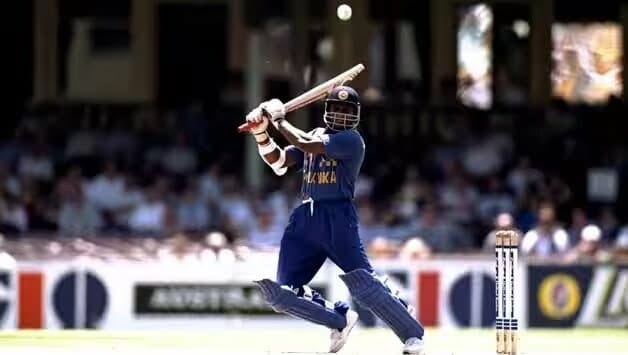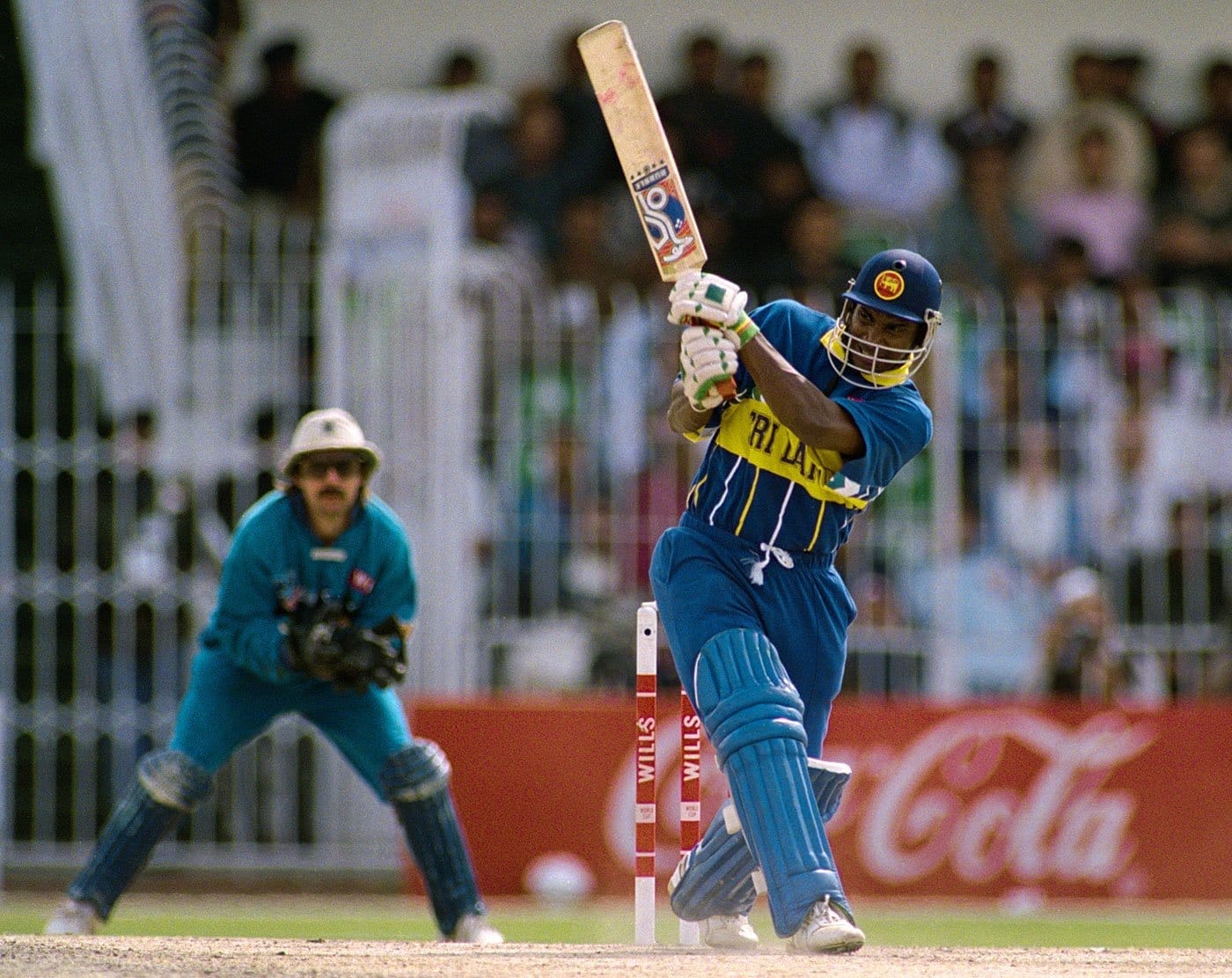Sri Lanka has produced many great cricketers since its emergence as a leading cricketing nation in the mid-1990s. Sanath Jayasuriya can truly be said to have been one of the most remarkable.
Jayasuriya was a player who did things differently. The fact that his career existed at all is an indication of this. He came from the south coast fishing port of Matara. Back then at the start of his career, in the late 1980s, it was almost unheard of for leading cricketers not to come from Colombo and the major schools there. Jayasuriya, as an outsider who ultimately rose to be the captain of his country and was for a while involved in national politics, showed a striking degree of ambition and perseverance; these qualities epitomised his on-field performances too. And his networking abilities had important consequences. In the first Test of 1999 Steve Waugh and Jason Gillespie suffered serious injuries when they collided in the field. Waugh said that Jayasuriya’s links with the military meant that a helicopter was made available to airlift the injured Australians to hospital.
It would be an exaggeration to say that Sri Lanka won the 1996 World Cup because of Jayasuriya; but it would be equally misleading to underestimate his influence. It did no harm to their chances, in fairness, that Australia and West Indies declined to travel to Sri Lanka to play their group matches there. Be that as it may, Jayasuriya and his opening partner, wicketkeeper-batsman Romesh Kaluwitharana launched into the opposition’s opening bowlers in a gloriously aggressive way and when it paid off it had a crucial impact on the result, allowing the more staid batsmen in the middle order (a description that cannot be allowed to include Aravinda de Silva) to play themselves in. The fact that both openers were allrounders also helped. Their uninhibited approach brought some amazing starts. Chasing 272 against India at Delhi, Sri Lanka were 42 for none after three overs. After 15 overs it was 115 for one. Jayasuriya made 79 and his side won by six wickets. Arjuna Ranatunga and Hashan Tillekeratne could take their time over their match-winning stand of 131. Against Kenya, at Kandy, the openers put on 83 in 40 balls. Then in the quarter final against England at Faisalabad, where England staggered to 235 for eight, Jayasuriya more or less guaranteed victory by smashing 82 off 44 balls (feature image); when he was out Sri Lanka were 113 for one, almost halfway home with 36 overs to go.
This was almost unprecedented. It was like T20 ten years ahead of its time. (Jayasuriya played long enough to see the start of the T20 era.) They called it pinch hitting and it was “almost” unprecedented because it had been seen before, at the previous World Cup, in 1992, when New Zealand’s Mark Greatbatch, on captain Martin Crowe’s instructions, would get his side off to a vigorous start. But of course there were two big differences. One was that Sri Lanka won the tournament, and New Zealand didn’t. The other was that for Greatbatch that was pretty well as good as it got. For Jayasuriya, the glory days were just beginning.
One of the most extraordinary things about Sri Lanka’s success in the 1996 World Cup was that Jayasuriya’s vital contribution to it came completely out of nowhere. Matthew Engel recognised the significance of that contribution by making him one of Wisden’s Five Cricketers of The Year for the 1997 edition of the Almanack. David Hopps in his essay on Jayasuriya, celebrated the potential greatness. Spectators, he said, “gaped in admiration” at his exploits.
Once he had been “discovered” by the national selectors Jayasuriya seized his chance, making two successive unbeaten double centuries against Pakistan B in 1988-89, and making his actual Test debut against New Zealand in 1990-91. He impressed on a short tour of England in 1990. Sri Lanka were back in England the following summer playing one Test and seven other first-class matches. Jayasuriya headed the batting averages, and in the Sri Lankans’ one victory, against Somerset, he and de Silva added 83 in eight overs to see the tourists home. In the Test, at Lord’s, he scored his first Test half century, making 60 off 70 balls in a losing cause. But he struggled a bit after that. His all round capabilities, including his brilliance as a fielder, made him a more obvious choice in limited overs cricket; by the time of the World Cup he had already played over 100 ODIs. In World Cricketers: A Biographical Dictionary, published in 1996, he was described fairly enough, as a forceful broad-shouldered left-hand batsman [sic] and a part-time left-arm spinner”. He had played 16 Tests and averaged 30.
The breakthrough was about to come. In his 17th Test, against Australia at Adelaide in November 1995 – the third Test in a controversial series which Australia won 3-0 – Jayasuriya opened the batting in a Test for the first time. Going in on the second evening after Steve Waugh’s declaration, he made 47 off 44 balls, cover driving Glenn McGrath for six and taking 13 off an over from Craig McDermott. In the second innings he scored 112 off 188 balls, with 14 fours and two sixes. It had been his first Test in 15 months; but he was a fixture now.
A few weeks after their World Cup triumph, Sri Lanka were in the Caribbean playing a one-off ODI against West Indies to celebrate the centenary of the Queen’s Park Oval. The visitors won the match, with Jayasuriya and Kaluwitharana putting on 67 in 6.2 overs for the first wicket.
In April 1996 the Singer Cup, featuring India, Pakistan and Sri Lanka, took place in Singapore. In Sri Lanka’s first game, against Pakistan, Jayasuriya made an astonishing 134 off 65 balls (he failed to score off his last nine), hitting 11 sixes and 11 fours. It was the fastest hundred in the history of limited overs internationals: he reached his century in 48 balls. In the final, also against Pakistan (which Pakistan won) Jayasuriya made the fastest half century in one day international history, reaching 50 off 17 balls. When Kaluwitharana was out, for nought, in the sixth over, Jayasuriya was 66 not out. He was out for 76, with eight fours and five sixes. That record has been beaten once, by A B de Villiers. De Villiers and five other batters have scored ODI hundreds faster than Jayasuriya’s.

As one can tell from all of this, Jayasuriya was a thrilling batter too watch. He was not a tall man – 5’6” – but he was immensely strong with powerful shoulders and forearms. His height meant that, inevitably he was very effective with the cut and the pull; Adelaide Oval, with its narrow boundaries on either side, was perfect for him. But he was also a beautiful driver of the ball, and like his near-contemporary and frequent batting partner de Silva, he was an exquisite timer of the ball. It was not uncommon, especially in England, to dismiss Jayasuriya as a slogger. Nothing could be further from the truth. He was a highly skilled technician who simply loved to attack. He could defend all right when he had to, or the mood took him. Even when he was attacking, what you saw were what they call “good cricket shots”.
Statistics can’t tell us everything but on the whole they don’t lie. Jayasuriya averaged just over 40 in his 110 Tests, and in the run-scoring list, with 6973, he is engagingly placed between Sir Donald Bradman (6996) and Sir Leonard Hutton (6971). He made 14 Test centuries, including a triple a double and a 199. The triple and the 199 came in the same series, against India, in 1997-98. In the first Test, at the R Premadasa Stadium in Colombo, Sri Lanka, in response to India’s 537 for eight, made 952 for six, the highest score in Test history. Jayasuriya made 340, threatening Brian Lara’s then record score of 375. He batted for 799 minutes without giving a chance, the second longest innings in first-class cricket. With Roshan Mahanama’s (225) he put on 576 for the second wicket, then the highest for any wicket in Tests. In the second Test at the Sinhalese Sports Club, Colombo, Jayasuriya made 199 off 226 balls. At one point he seemed likely to break the record for the fastest Test double century, then held by Ian Botham, but he lost a little momentum.
His record in one-day internationals is, if anything, even more impressive. He played no fewer than 445 matches between 1989 and 2011. He is the fourth highest run scorer in ODI history, with 13,430 runs, behind Sachin Tendulkar, Kumar Sangakkara and Ricky Ponting. His career strike rate of 91, is exceeded by only one of the top 16 run scorers, Virender Sehwag.
And what about the “part time left-arm spinner”? It is true that he was never much of a force in Test cricket, but in ODIs, it was a different matter. His 323 wickets put him eleventh on the all time wicket taking list. Of those above him in the list only Shahid Afridi, with just over 8000 runs, approached his total with the bat, so there is a good case for saying that Jayasuriya is the greatest all rounder in ODI history.
For fans outside the subcontinent he was seen at his best in the famous victory over England at The Oval in 1998. He made a glorious 213 off 278 balls, with 32 fours and a six. His rate of scoring enabled master tactician Arjuna Ranatunga to execute his cunning plan of winning by an innings after asking the opposition to bat first.
Where does Jayasuriya stand in the pantheon? He was not one of his country’s great captains, though he was the obvious choice to succeed Ranatunga after the disastrous World Cup defence in 1999. There have been troublesome issues since his retirement as a player. But it is his playing record we are concerned with. Christopher Martin-Jenkins, in his Top 100 Cricketers of All Time, puts Jayasuriya in at number 67. That seems a reasonable choice.




